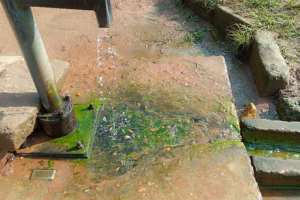
Research conducted by Ghana Environmental Community for Sustainability (GECS) in partnership with the Coalition of Non-Governmental Organisations (NGOs) in Water and Sanitation (CONIWAS) in the Wassa East District in the Western Region revealed that over 80 percent of water facilities dotted across the district were below the minimum intentional certification.
According to the researchers, only two out of the number of water sources/facilities met the minimum intentional certification standard.
One common observation which runs through was that almost all the 12 water samples have low pH levels.
The study, therefore, recommends that the pH of the water sources in the district should be improved which includes periodic testing of water samples.
It added that there should be a conscious effort to properly formalised regulations on indiscriminate disposal of waste. Training and education on climate change adaptation should be widened to include civil society and students.
A total of 12 water samples were randomly collected from water sources in 12 selected communities in the Wassa East District. Out of these samples, eight were from boreholes, three from streams, and one, from pipe-borne water.
Presenting the research findings at a stakeholders engagement at Cocoanut Grove hotel, the head of the research team, Mr. Evans Agyei Ntiamoah told the gathering that Aseptic sampling methods were used to ensure the properties of the water samples are not compromised.
According to him, the sample bottles were rinsed thoroughly before sampling was done. The samples he explained were stored in a cold bath and transported to the Center for Scientific and Industrial Research-Water, a research institute in Accra for physicochemical and microbiological analysis.
He stressed that physicochemical parameters of interest in this research were potential of Hydrogen (pH), conductivity, turbidity, colour, hardness, Total Dissolved Solids (TDS), and Total Suspended Solids (TSS).
The outlined procedure to document and campaign for water and climate justice in the Wassa East District (WED) was in four-folds, accessing areas like; accessibility of quality water supply, ground and surface water quality, sanitation, environmental health, and safety risks (Including COVID-19 resilience) and climate-induced risk and adaptation strategies implemented.
A cross-sectional descriptive and analytical design was used. Self-administered questionnaires were used to collect data from 332 research participants in 30 towns. Additionally, 12 water points (Pipe water, river, stream, mechanised boreholes) were sampled and analysed. ArcGIS 10.7 and SPSS were used for data analysis.




 We’ll protect state wealth from opaque deals – Prof Jane Naana
We’ll protect state wealth from opaque deals – Prof Jane Naana
 Mauritania president says running for second term in June polls
Mauritania president says running for second term in June polls
 I won't ever say I was a mere driver’s mate' — Prof. Opoku-Agyemang
I won't ever say I was a mere driver’s mate' — Prof. Opoku-Agyemang
 2024 polls: 'EC struggling to defend credibility'— Prof. Opoku-Agyemang
2024 polls: 'EC struggling to defend credibility'— Prof. Opoku-Agyemang
 Akufo-Addo gov't's 'greed, unbridled arrogance, unrestrained impunity, sheer dis...
Akufo-Addo gov't's 'greed, unbridled arrogance, unrestrained impunity, sheer dis...
 Election 2024: Ghana needs an urgent reset, a leadership that is inspiring – Ma...
Election 2024: Ghana needs an urgent reset, a leadership that is inspiring – Ma...
 Partner NDC to rollout a future of limitless prospects – Prof Jane Naana Opoku-A...
Partner NDC to rollout a future of limitless prospects – Prof Jane Naana Opoku-A...
 NPP will remain in gov’t till Jesus comes — Diana Asamoah
NPP will remain in gov’t till Jesus comes — Diana Asamoah
 Sunyani Technical University demands apology from former SRC president over sex-...
Sunyani Technical University demands apology from former SRC president over sex-...
 'Dumsor' was resolved by Mahama but ‘incompetent' Akufo-Addo has destroyed the g...
'Dumsor' was resolved by Mahama but ‘incompetent' Akufo-Addo has destroyed the g...
